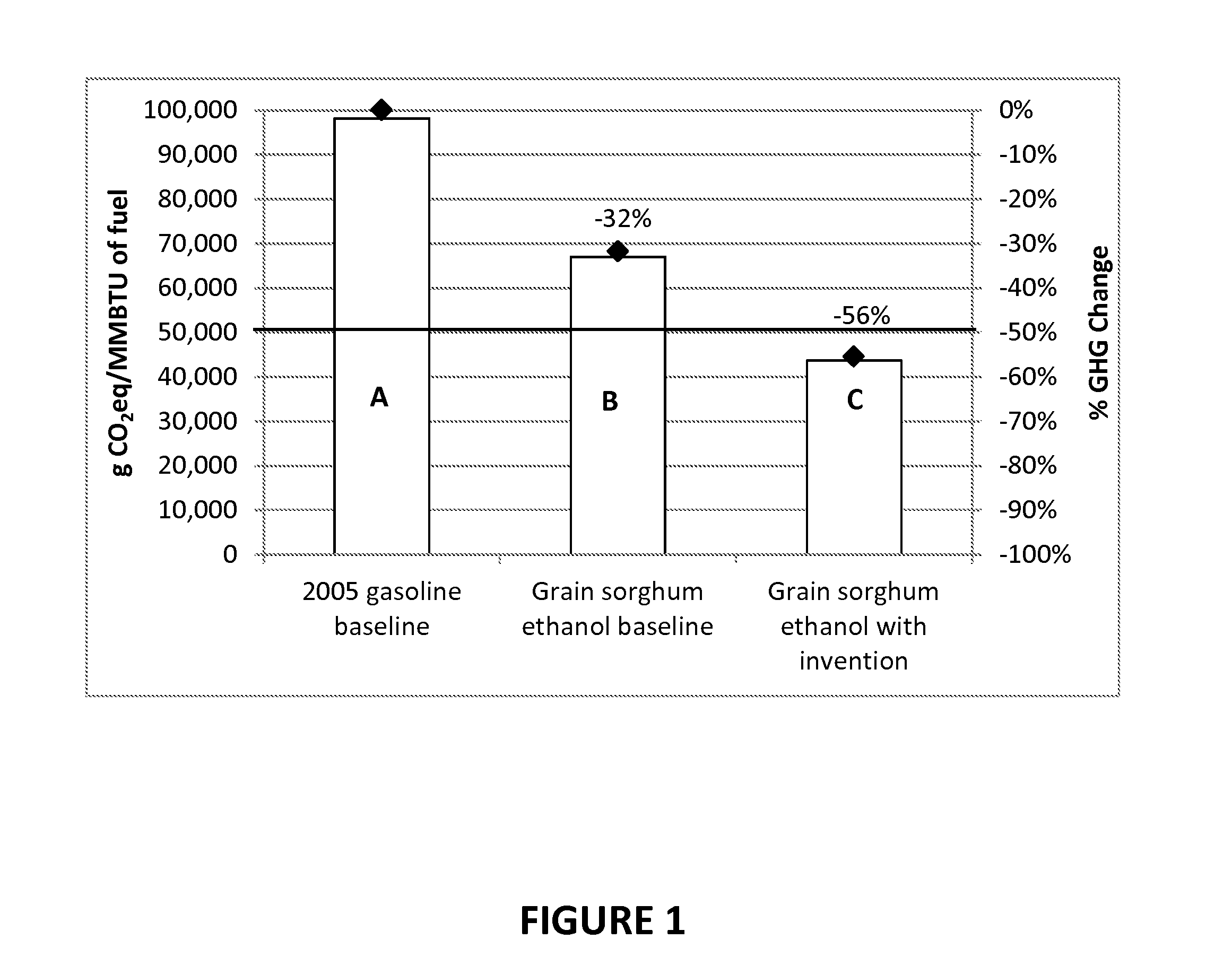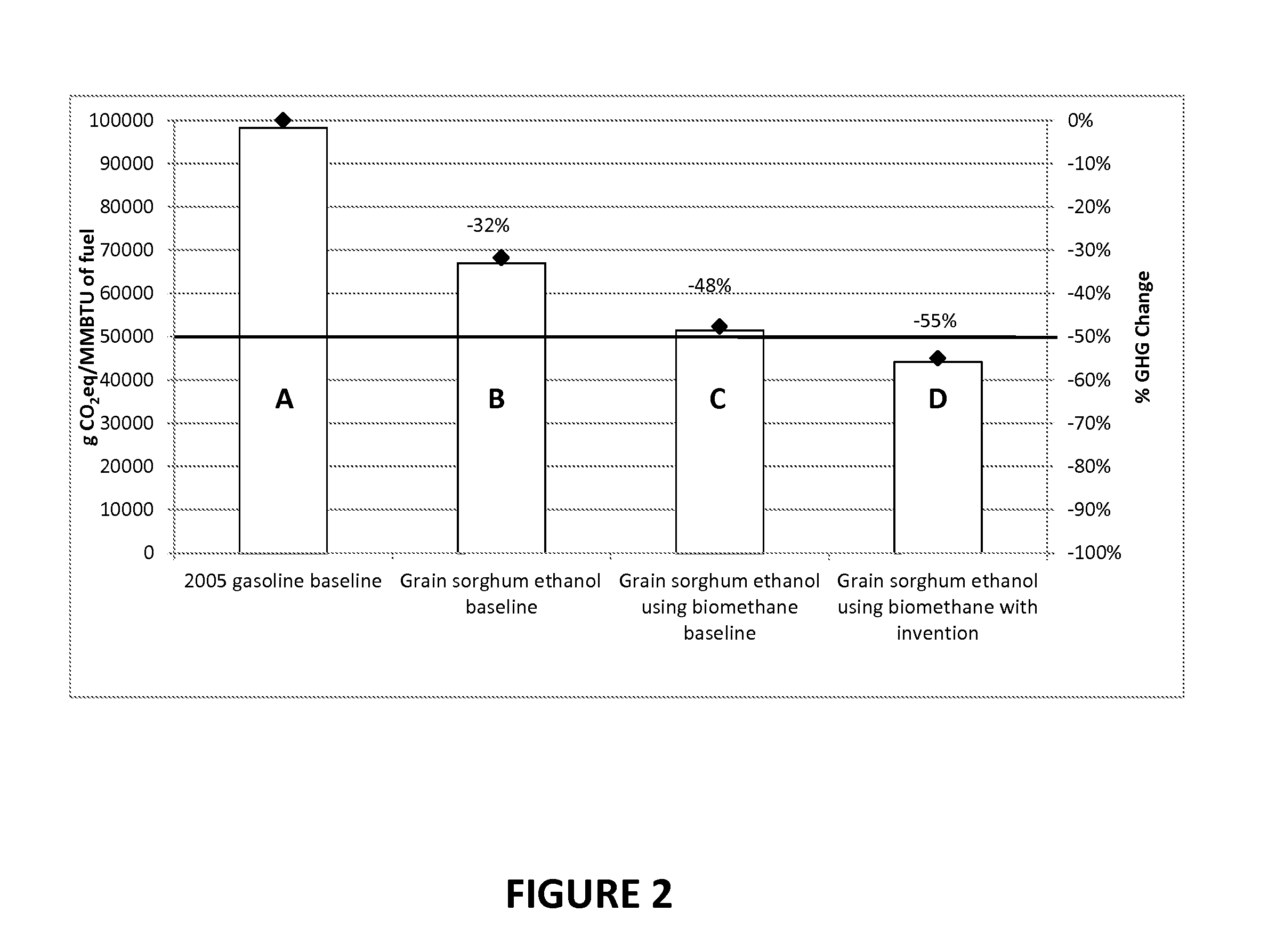Method to reduce ghg emissions of fuel production
- Summary
- Abstract
- Description
- Claims
- Application Information
AI Technical Summary
Benefits of technology
Problems solved by technology
Method used
Image
Examples
example 1
Reducing the Life Cycle GHG Emissions Associated with a Liquid Fuel by Collecting Biogenic Carbon Dioxide and Displacing Geologic Carbon Dioxide in Enhanced Oil or Gas Recovery
[0194]This example illustrates how a dry mill ethanol plant processing sorghum to ethanol can reduce its life cycle GHG emissions to below 50% of the gasoline baseline value used by the EPA under EISA by collecting biogenic carbon dioxide and displacing geologic carbon dioxide in or associated with enhanced oil or gas recovery. Advantageously, by meeting this GHG emission threshold, the ethanol qualifies for D5 RINs under the RFS. In this example, the life cycle GHG emissions of the fuels are compared using EPA GHG emissions methods and their 2022 scenario for certain GHG values (see EPA-HQ-OAR-2011-0542; FRL-9680-8, Notice of Data Availability Concerning Renewable Fuels Produced From Grain Sorghum Under the RFS Program). The percentage GHG reductions relative to the gasoline baseline are calculated are based ...
example 2
Using the Invention to Increase the Generation of LCFS Credits in a Biogas Derived Fuel
[0207]The present invention also allows a landfill gas collection operation using biomethane from landfill organic waste to make compressed natural gas (CNG) for vehicle use, and achieve a greater degree of LCFS credit generation from the operation, as shown below. The calculations are based on California's LCFS regulations.
(a) Baseline Emissions for Natural Gas Based CNG
[0208]The California Air Resources Board (CARB) has determined life cycle GHG emissions values for CNG derived from natural gas and CNG from landfill biomethane as in Table 8 below.
TABLE 8Life cycle GHG emissions values for CNG derived from natural gas andbiomethaneLCFS CreditsEmissions ValueGenerated by FuelFuel(g CO2eq / MJ)Use (g CO2eq / MJ)California Gasoline95.860CNG derived from natural gas67.728.16CNG derived from landfill11.384.56biomethane
(b) Emission Reductions Due to the Invention
[0209]Anaerobic digestion of organic materia...
example 3
Reducing the Life Cycle GHG Emissions Associated with a Liquid Fuel by Using Methane Having Reduced Life Cycle GHG Emissions
[0214]The present invention also enables a liquid fuel production facility, such as an ethanol production facility, to reduce the life cycle GHG emissions of the liquid fuel by using methane having reduced life cycle GHG emissions to provide energy to the production facility or associated utilities.
[0215]According to this example, biomethane and biogenic carbon dioxide is generated in a landfill by anaerobic digestion and the biomethane is then separated from the carbon dioxide. The carbon dioxide that is collected is used in an enhanced oil or gas recovery operation to displace geologic carbon dioxide, while the biomethane is supplied for use in the liquid fuel production facility or utilities to generate energy in the form of heat or electricity. The decrease in emissions associated with the use of such low GHG methane for energy production permits the liquid...
PUM
 Login to View More
Login to View More Abstract
Description
Claims
Application Information
 Login to View More
Login to View More - R&D
- Intellectual Property
- Life Sciences
- Materials
- Tech Scout
- Unparalleled Data Quality
- Higher Quality Content
- 60% Fewer Hallucinations
Browse by: Latest US Patents, China's latest patents, Technical Efficacy Thesaurus, Application Domain, Technology Topic, Popular Technical Reports.
© 2025 PatSnap. All rights reserved.Legal|Privacy policy|Modern Slavery Act Transparency Statement|Sitemap|About US| Contact US: help@patsnap.com


